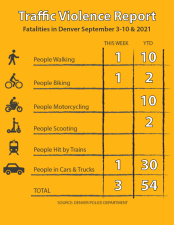Commentary: The University of Colorado Name on RTD’s A Line Is the Dumbest Thing
The commuter train doesn’t stop at any CU campus or its hospital complex


Why did officials at the Regional Transportation District allow the University of Colorado to slap its name onto the A Line airport train, confusing riders with a transit line that serves none of CU’s four campuses or its medical complex in Aurora?
CU paid RTD $5 million for the naming rights in a five-year deal that will end next year. But shouldn’t RTD put their riders first and reject a deal that heaps a layer of uncertainty onto the minds of riders as they try to navigate their system?
As someone relatively new to Denver, it left me scratching my head. And for good reason.

Around the world, transit maps have adopted universal norms, including naming important stops for well-known activity centers. The kinds of places that make it onto such maps include major landmarks, intersections, hospitals and, of course, universities.
These conventions allow people to make assumptions. When I look at RTD’s rail map, I know that the stops named for the Convention Center, Broncos Stadium or Red Rocks College will get me to those places.
Elsewhere in the world, when you see a university on the map, that’s what you’ll find in Washington D.C., Mexico City, Paris, Taiwan, Cairo and anywhere else that has a transit map and an institution of higher learning.
But when RTD plasters the name of the University of Colorado onto a train that doesn’t go to the home of the Buffalos, that upends this tradition. It takes this global convention to the steepest peak of the Flatirons and shoves it right off.
Quick poll: RTD's University of Colorado A Line doesn't go near any of the CU campuses. Is that confusing?
— Streetsblog Denver (@StreetsblogDen) April 24, 2019
An informal poll on Twitter shows that many think the CU name on the A Line is confusing.
For many riders, approaching a public transit system for the first time confuses them in the best of circumstances. When people are in an unfamiliar place, as many airport train passengers certainly are, stepping onto a train can rattle the nerves. You’d expect that the people behind a multimillion dollar advertising effort would understand that, dismissing the naming idea as a marketing tactic that would add a layer of anxiety when their goal is to engender a positive association with their brand.
But the marketing folks went for it, inadvertently making the CU name something that bewilders and baffles people. That strikes me as “off brand,” because one of the core things that universities do is help people understand knowledge. Creating confusion runs against the values of the University of Colorado, does it not?
Ken McConnellogue, vice president of communications for the University of Colorado says they’re not muddling the minds of A Line riders.

“I disagree with you that we’re causing confusion,” he said. “People don’t go to the Pepsi Center to buy Pepsi, or to Coors Field to buy Coors.”
But if the A Line were named for Pepsi, Coors or even Swiffer, people would not expect to go to to these products. That’s because they are beverages and consumer products, not places. Universities are indeed places.
And unlike corporate brands, CU is a public institution. We’re not used to seeing aggressive marketing tactics from colleges, especially when they’re combined with another public institution, like RTD.
McConnellogue thought I was taking things too far.
“I think it’s a stretch,” he said. “Frankly I’m not following your logic on this one.”
That’s why I hopped onto the A Line this afternoon at Union Station and talked to Becky Hollingsworth, who was taking the train to the 40th Ave stop on her way home. She finds the name puzzling.
“If that’s the name and where you’re going, to have it not get you there, that does seem confusing,” she said.
But the name of the train did not prevent her from using the A Line to get to her destination, a point highlighted by Pauletta Tonilas, RTD’s Assistant General Manager of Communications. People can research their trips with maps at the stations, on the RTD website or via mobile apps like Google Maps, she said.

“If [passengers] want to go to the Boulder CU, they would easily be able to find that you can take the University of Colorado A Line downtown and hop on the Flatiron Flyer,” Tonilas said. “And that’s what’s going to take you to Boulder.”
She pointed out that the A Line connects to the R Line, which goes to the University of Colorado Anschutz medical campus. The A line also ends at Union Station, which is a 14-minute walk from the CU Denver student center, according to Google Maps.
How often do riders complain about the name, I asked? Of all of the problems that come to RTD’s customer service team, it doesn’t come up often according to Laurie Huff, a spokesperson for the agency.
“They do on occasion field questions and comments as to why the University of Colorado A Line does not go directly to the university,” she wrote in an email. “But that doesn’t happen very often.”
After talking to CU and RTD officials, I’m still convinced that putting the university’s name on a transit line that doesn’t go there is a harebrained idea.
And where do bad marketing ideas come from? In this case, I don’t know. But the brainstorming process at the fictional public relations firm PubLIZity came to mind.
Support Streetsblog Denver. Give $5 per month.


